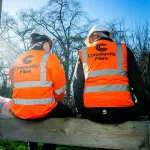BT Ultrafast Broadband Covers 886K UK Premises as Pay TV Shrinks
BT has released their latest results to the end of 2017 (Q4 calendar), which saw their retail UK broadband ISP base add 35K subscribers to total 9,342,000 (vs +22K in Q3). Meanwhile their FTTP and G.fast “ultrafast broadband” (100Mbps+) services reached 886,000 premises (up from 770K).
As usual the operator also includes an update on their capital expenditure and clawback (gainshare) from the Government’s Broadband Delivery UK roll-out scheme (i.e. public investment returned by BT due to rising take-up in FTTC/P covered areas), which reveals that £527m (up from £477m last quarter) of public funding may potentially become available for reinvestment into further UK coverage of “fibre broadband” services.
In addition, BT said that their base-case assumption for take-up in BDUK areas had risen from 39% of total homes passed to 40%. The Government intends to use this reinvestment to help push the coverage of “superfast broadband” to approximately 98% of UK premises by around 2020 (here).
Advertisement
Financial Highlights – BT’s Quarterly Report
* BT Group quarterly revenue = £5,970m (up from £5,951m in Q3 2017 calendar)
* BT Group reported profits before tax = £660m (down from £666m)
* BT Group total net debt = £8,923m (down from £9,520m)
* BT Wholesale quarterly operating profit = £110m (up from £109m)
* Openreach quarterly operating profit = £305m (up from £277m)
* Openreach quarterly capital expenditure = £477m (up from £397m)
Otherwise the main changes since the last report have been the launch of BT’s new “ULTRAFAST Fibre” (G.fast and FTTP) based broadband packages (here) and yesterday’s announcement by Openreach of a faster roll-out plan for “full fibre“, which will see their FTTP technology cover 3 million UK premises by 2020 instead of the previous target for 2 million (here).
BT Consumer / Retail
The retail side of BT’s broadband business still holds the single largest share of “fibre broadband” (FTTC/P) subscriptions on Openreach’s national UK network, which saw them add a respectable 208,000 customers in the quarter to total 5.492 million.
Meanwhile BT’s mobile base (EE) grew and their 4G subscribers jumped from 19.4 million last quarter to 19.6 million now. We also note that for the first time BT’s Pay TV (IPTV) base has begun to shrink, losing -5,000 customers in the quarter.
| Broadband Subs | TV Subs | Mobile Subs + EE |
Fibre Subs | |
| Q4 2017 TOTAL |
9,342,000 | 1,760,000 | 29,762,000 | 5,492,000 |
| Subs Change (Q4) | +35,000 | -5,000 | +40,000 | +208,000 |
| Q3 2017 TOTAL |
9,307,000 | 1,765,000 | 29,736,000 | 5,285,000 |
| Subs Change (Q3) | +22,000 | +7,000 | -45,000 | +179,000 |
On top of all that BT also reported that EE’s geographic (landmass) 4G network coverage of the United Kingdom has now reached 90% (up from 86% last quarter) and they aim to cover 95% by the end of December 2020, although the latter aim doesn’t get a mention in today’s report.
Advertisement
Openreach & Wholesale
Openreach’s national telecoms and broadband network serves various ISPs across the United Kingdom, including BT itself (i.e. the total broadband and “fibre” lines listed below combine customers from BT’s own service as well as many other ISPs).
At present the operator’s “fibre” network covers 27.4 million UK premises (up from 27.1m in the last quarter) and the majority of those are reached via their slower ‘up to’ 80Mbps capable FTTC (VDSL2) services. Around 886,000 of that total can now also access an FTTP or G.fast based “ultrafast broadband” (100Mbps+) connection, which is up from 770,000 last quarter.
G.fast is still in the pilot stage but should cover 1 million premises by the end of March 2018, before rising to 10 million by 2020 (the total rises to 13 million when FTTP is included). The recent launch of BT’s commercial ‘ULTRAFAST Fibre‘ packages show that this service is now starting to go mainstream.
Note: This time around we’ve stopped tracking unbundled (LLU) lines because the fibre figures are now more important. Unbundled lines are mostly used by ISPs that have installed some of their own kit inside Openreach’s network in order to gain more control over their products and prices, although they’re of more use for the older generation of copper based services.
Advertisement
| Total UK Broadband Lines (ADSL, Fibre) |
Fibre Lines (FTTC / FTTP / G.fast) |
|
| Q4 2017 TOTAL |
20,645,000 | 9,241,000 |
| Lines Change (Q4) | +157,000 | +600,000 |
| Q3 2017 TOTAL |
20,489,000 | 8,640,000 |
| Lines Change (Q3) | +64,000 | +505,000 |
It’s worth noting that the quarterly increase of +600,000 in new “fibre broadband” (FTTC/P) lines also includes the +208,000 added via BT’s own ISP. The outcome means that BT’s rivals accounted for +392,000 of the total increase (up from +326K last quarter). Separately, BTWholesale delivered a total of just 863,000 external broadband lines for other ISPs, which is down by -14,000 in the quarter.
Gavin Patterson, CEO of BT Group, said:
“Our third quarter financial results are broadly in line with our expectations and we remain confident in our outlook for the full year. We continue to improve our customer experience metrics across the Group, with our sixth successive quarter of improved customer perception.
We continue to work closely with the UK Government, Ofcom and our customers to expand the deployment of fibre and Openreach recently announced plans to accelerate our FTTP deployment to three million premises by the end of 2020.
We agreed a reciprocal wholesale deal with Sky that will deliver market leading sports and entertainment channels to our BT TV platform by early 2019, reinforcing our strategic goal of being the best provider in the UK of converged network services.
The triennial valuation of the BT Pension Scheme is proceeding and constructive discussions continue with the BTPS Trustee. We still expect to complete the valuation in the first half of the 2018 calendar year. Our aim remains to deliver fair, flexible and affordable pensions to all of our employees.
We are delivering against our strategy, capitalising on opportunities and responding to market challenges with a robust set of actions. Looking ahead, we’re confident in the steps we are taking to improve the performance of BT for all our stakeholders.”
The biggest challenges for BT in 2018 are likely to centre around a combination of the outcome from Ofcom’s current wholesale market reviews (related price changes and new regulation etc.), the Government’s final design for the 10Mbps Universal Service Obligation (USO) for broadband connectivity and Openreach’s on-going efforts to agree a Network Strategy for bringing FTTP to 10 million premises by 2025.
On top of that they’ll also be bidding on a number of the forthcoming auctions for new radio spectrum bands (2.3GHz and 3.4GHz), which Three UK are still trying disrupt. Lest we forget Ofcom’s second attempt to introduce a Dark Fibre Access (DFA) remedy for Ethernet services at and below 1Gbps from April 2018 until April 2019 (here).
Mark is a professional technology writer, IT consultant and computer engineer from Dorset (England), he also founded ISPreview in 1999 and enjoys analysing the latest telecoms and broadband developments. Find me on X (Twitter), Mastodon, Facebook, BlueSky, Threads.net and Linkedin.
« Q4 2017 Map of Europe and UK Countries by Mobile Data Speed
Get a Free Google Home with UK ISP John Lewis Broadband »
















































Comments are closed